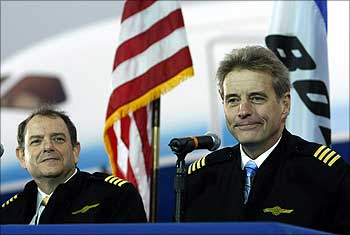
Air India will be the first Indian carrier to acquire the ultramodern Boeing 787 Dreamliner. However, the airline will get its first 787 Dreamliner in the second quarter of 2011, according to Dinesh Keskar, president, Boeing India.
Air India has ordered as many as 27 Dreamliners from the Seattle-based aerospace giant. Apart from Air India, Jet Airways too will buy 10 Dreamliners from Boeing.
December 15 was a red letter day in the history of The Boeing Company as Boeing 787 Dreamliner made its first flight on that day.
Boeing's 787 Dreamliner, a project which was marred by repeated delays and obstacles, is an instance of the most advanced aviation technology available. Its aerodynamic design, engines, flight controls and avionics are almost part of the aviation folklore.
"This jet, the first conceived and built in the 21st Century, is anything but basic," wrote Michael Mecham in Aviation Week, website of Aviation Week & Space Technology magazine.
"One bullish analyst once referred to it as the 'iPhone of aviation,' high praise indeed.' But from the passenger's point of view, the desire to fly safely, comfortably, and without drama is more important than how all the new gizmos work.

No one can fully guarantee on-time arrivals, sufficient legroom for taller passengers, or the quality of food. But Boeing says that those flying aboard the 787 can expect a better experience.
According to Boeing, some of the improved features of the aircraft include:
Despite problems with labour and delays in the delivery of aircraft components from a global network of suppliers, which caused a two-year delay, Boeing's customers around the world are lining up to buy the Dreamliner at about $150-million a plane. Some 55 airlines have ordered 840 787s.

Over the next 9 to 12 months, Boeing will test fly six 787s before delivering the first Dreamliner to Japan's All Nippon Airways. Boeing plans to open a second 787 manufacturing plant in South Carolina.
A successful test flight On Tuesday, under a typically leaden winter sky near Seattle, pilots Michael Carriker and Randall Neville took off to the north accompanied by a pair of T-33 jet trainers, then turned west for just over three hours of basic flying before returning to land on a rainy runway.
The purpose, said Boeing spokesman Jim Proulx, was to 'make sure that the airplane under normal circumstances flies the way it's supposed to fly.'
The 787 version tested Tuesday will be able to carry up to 250 passengers as far as 9,000 miles. A stretch version will be capable of carrying 290 passengers and a short-range model up to 330.